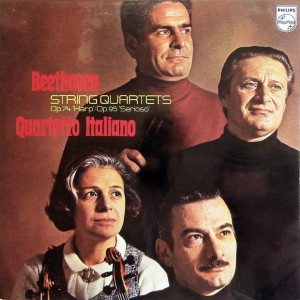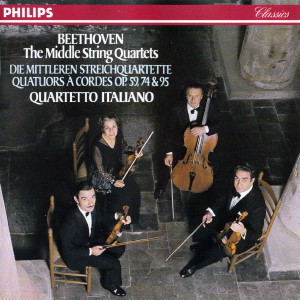 |
|
Philips
- 1 LP - 6500 180 - (p) 1971
|
 |
| Philips
- 3 CDs - 420 797-2 - (c) 1989 |
|
| Ludwig van
Beethoven (1770-1827) |
|
|
|
|
|
|
|
| String
Quartet No. 10 in E flat major,
Op. 74 "Harp" |
|
32' 34" |
|
| -
Poco adagio - Allegro |
10' 16" |
|
|
| -
Adagio ma non troppo |
10' 05" |
|
|
| -
Presto - Pił presto quasi
prestissimo - |
5' 25" |
|
|
| -
Allegretto con variazioni |
6' 48" |
|
|
|
|
|
|
| String
Quartet No. 11 in F minor, Op. 95
"Serioso" |
|
20' 22" |
|
-
Allegro con brio
|
4' 19" |
|
|
| -
Allegretto ma non troppo - |
6' 58" |
|
|
-
Allegro assai vivace ma serioso
|
4' 07" |
|
|
| -
Larghetto espressivo - Allegretto
agitato |
4' 58" |
|
|
|
|
|
|
QUARTETTO ITALIANO
- Paolo Borciani, Elisa Pegreffi, violino
- Piero Farulli,
viola
- Franco Rossi, violoncello
|
|
|
|
|
|
Luogo e data
di registrazione |
|
La
Salle des Remparts,
La Tour-de-Peilz (Svizzera)
- 20-31
luglio 1971 - (Op. 74)
-
15-27 gennaio 1971 -
(Op. 95) |
|
|
Registrazione: live
/ studio |
|
studio |
|
|
Producer / Engineer |
|
Vittorio
Negri | Tony
Buczynski, Ko
Witteveen |
|
|
Prima Edizione LP |
|
Philips | 6500
180 | 1
LP | (p) 1971
|
|
|
Prima Edizione CD |
|
Philips | 420 797-2
| 3
CDs - 40'
29" - 58' 51" - 64' 35" - (2*,
5-8; 3°, 5-8) | (c)
1989 | ADD
|
|
|
Note |
|
L'edizione
in CD contiene anche i
Quartetti Op. 59
nn. 1, 2 e 3.
|
|
|
|
|
Towards the
end of the first decade of
the nineteenth century, a
period that was especially
productive for Beethoven
(including as it did
Symphonies Nos. 2 to 6,
the Piano Concertos Nos. 2
to 5, The Violin Concerto,
the Mass
in C, and "Fidelio"), a
new development set in,
which manifestes itself
particularly in the
Quartets Op. 74 and Op.
95.
Despite
the disparity in their
opus numbers these
works were written
within a year. All the
more surprising then
is the difference in
their characters. The
Quartet in E flat is still
very strongly linked
with the past;
engaging and
unproblematic, it is
a work of beauty and
charm. The Quartet
in F minor, on the
other hand, looks
forward in time,
revealing already
characteristics of
the late quartets;
austere, sober, and
difficult,
compressed and
reduced to
essentials, it
nevertheless
dispalys expressive
power and spiritual
intensity. In both
works one senses a
striving to
relinquish the
pedantic padding of
academic forms, and
a corresponding
masking of key and
the contours of
themes and cadences,
together with the
quest for new tonal
effects.
The Quartet
in E flat, like
the "Emperor"
Piano Concerto,
was completed in
the autumn of
1809, while
Beethoven was
staying at Baden
near Vienna. The
opening of the
first movement is
highly reminiscent
of the celebrated
motif "Muss es
sein?" ("Must it
be?") from the
late Quartet in F,
Op. 135. after a
brief, slow
introduction an
arpeggio theme
leads into the Allegro
proper, clearly
anticipating the pizzicato
passage which
follows
immediately and
recurs repeatedly
in the course of
the movement being
devised obviously
as a special tonal
effect. The
scoring for the
individual
instruments in
alternating half
bars over a range
of up to three
octaves produces a
remarkably
plastic effect,
and from
this the work
acquired its
nickname of
"Harp."
The
second
movement has a
beatiful,
fervent
melody, and in
addition a
chorale-like
accompaniment
with episodic
variations
reminiscent of
the adagios
of the early
symphonies.
What is here
evoked is the
calm before
the storm.
Soon the Presto
of the third
movement, a
furious
scherzo,
bursts upon us
with unrestrained
exuberance. A
second, fugal
section (Pił
presto quasi
prestissimo)
is introduced
fortissimo
by the cello.
The unusual
recapitulation
scheme of
playing the
first section
three times
and the second
section twice
provoked a
query from the
publisher.
Beethoven
insisted on
his
instructions;
he had an
unerring
feeling for
what was
right. As a
result one
enjoys even
the third
repeat of the
first section
as it sweeps
along.
The
variations on
a friendly
allegretto
theme which
form the
finale appear
strikingly
simple in the
context of
Beethoven's
variation
technique,
which even at
that time was
fully mature.
There is no
change of key
or tempo but
simply changes
in the
sequence of forte
and piano
and the
figuration.
If
the Leipzig
"Allgemeine
Musikalische
Zeitung" of
May 22, 1811
could observe
that the
quartet as a
musical form
coult not have
the purpose of
"honouring the
dead or
dipicting the
feelings of
those in
despair, but
should amuse
the mind by
the gentle,
pleasure-giving
play of
phantasy,"
then it is
hardly
surprising
that
Beethoven's
contemporaries
should be
deterred by a
work like the
Quartet in F
minor, Op. 95.
This he knew
well enough.
For six years
he held this
work back from
publication -
a work that
heralded
a new artistic
direction.
The
first bar of
the quartet
contains the
germ of the
complete first
movement, a
passage played
in unison by
all four
instruments.
Within the
space of a few
bars the
fundamentally
sober and
abjective
character of
the whole work
is revealed;
the sudden and
abrupt octave
leaps of the
first violin
in a
march-like
rhythm are
adhered to by
the other
instruments
too. Here
clearly
delineated
themes have
given way to
thematic
material. By
concealing the
distinction
between
melodic and
accompanying
parts the
movement is
typical of
Beethoven's
middle period
- one thinks
emmediately of
the famous
"Appassionata
Sonata."
Contributing
to the
harshness of
sound are
recurrent
stereoyped
accompaniment
figures, for
instance
the
octave-leeaping
semiquaver in
the first
violin. The
tendency to
imply rather
than fully
express
manifests
itself
particularly
in the final
cadences of
the movement:
the cadences
up to
that point
have nothing
of the same
immediacy.
In
a most
original
manner the
second
movement
begins with a
simple
descending
phrase only
four bars
long,
presented
like a
programme by
the solo
cello. The
movement's
individual
character is sustained
by the
Baroque-like fugato,
introduced
later by the
viola, in
which the
polyphonic
interweaving
forms a
striking
contrast to
the
stereotyped
figures of the
first
movement. The
third movement
ought really
to be a
scherzo. And
indeed
scherzo-like
material is
one way or
another
introduced, as
far as the
fundamentally
serious and
occasionally
gloomy mood of
the work
allows. Bu the
movement is
aching and
passionate
instead of
joyous and
gay, in
accordance
with the
marking Allegro
assai vivace
ma serioso.
The strange
trio has a
uniformly
flowing
accompaniment
by the first
violin,
against which
the other
instruments,
in leisurely
fashion, play
episodes like
parts of an
old chorale,
broken up
by intervals
of several
bars in which
only the upper
accompaniment
is heard.
In
the finale, however,
the first
violin
reappears in
its usual
leading role
and in other
respects too
the movement
is highly conventional.
Although at
the first
hearing the
work may seem
rather
forbidding, it
is without
doubt a
significant
step in the
development
toward
Beethoven's
much
misunderstood
late works.
The
period from
wich it dates
marked a
turning-point
in both his
life and
music. In 1809
Vienna
trembled in
the caos
resulting from
the entry of
the French.
Another factor
was
Beethoven's
personal
destiny ("the
daemon in my
ears") which
he lamented to
his friend
Wegeler in a
letter of May
2, 1810: "Oh
life is so
beautiful, but
for me it is
for ever
poisoned." And
Therese
Malfatti is
said to have
turned down at
this tima a
proposal of
marriage from
him. His
statement in aletter
to Therese. "I
am living a
very lonely, quiet
life," surely
finds its
musical
expression in
the intensely
introverted Op.
95.
A
perceptible
inclination to
polyphonic
style is quite
certainly
connected in
some way with
his
contrapuntal
studies for
tuition of the
Archduke
Rudolph at
that time.
Finally,
changed
cirmustances
affecting his
material
standard of
living ought
not to be
understimated.
An annual
salary
guaranteed for
life by three
princes
relieved
Beethoven of
the need "to
write for
bread," while
at the same
time providing
him with a
clear path to
new goals.
Dr.
Hans Schmidt
|
|
|